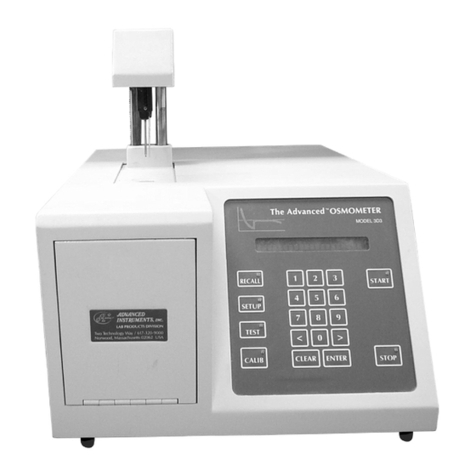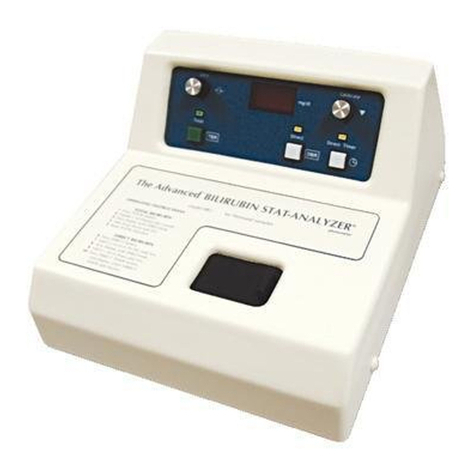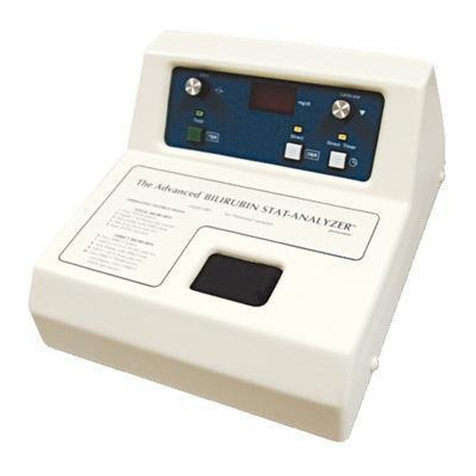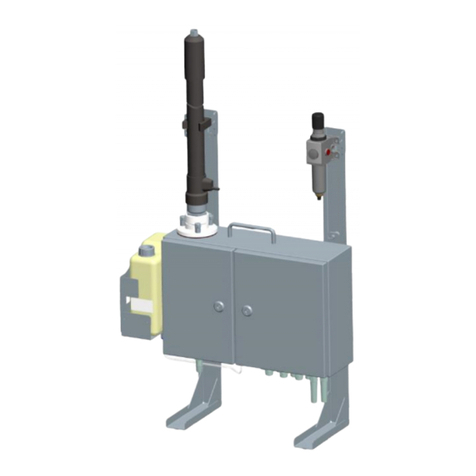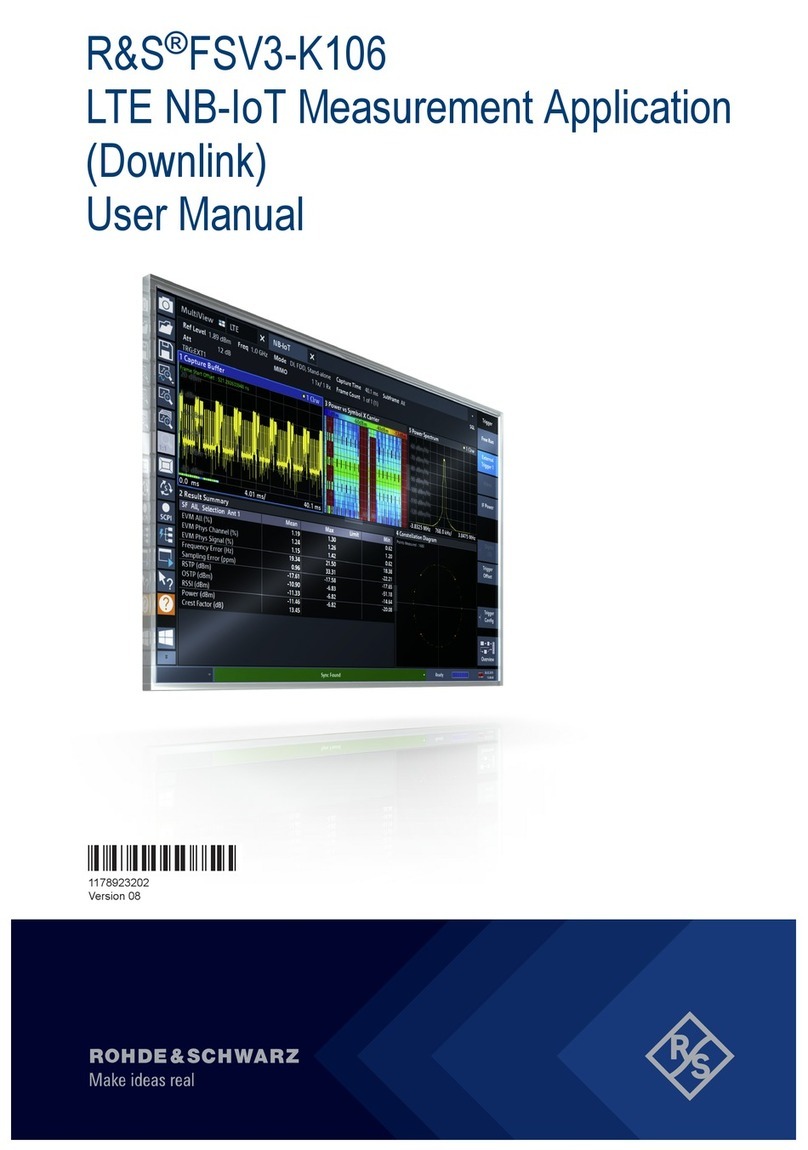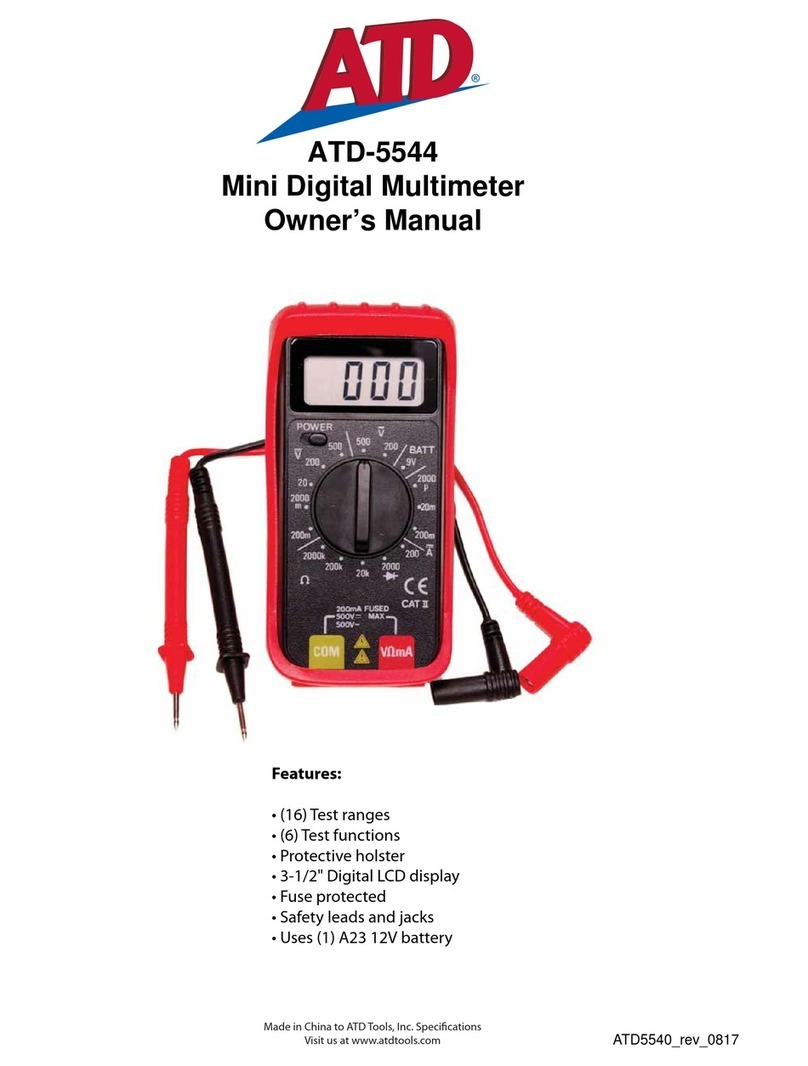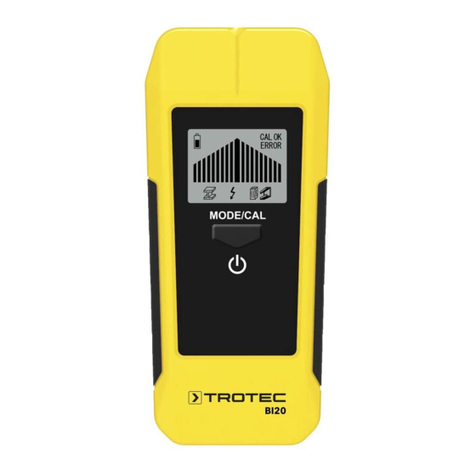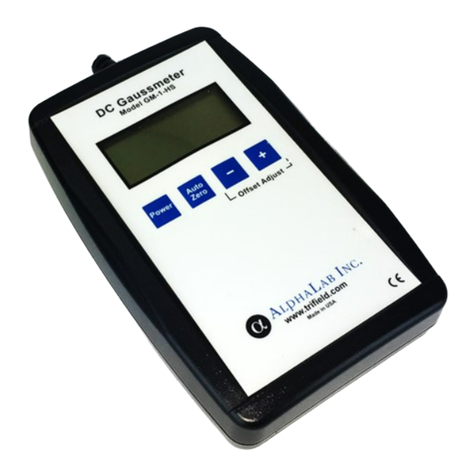Advanced 3320 User manual

3325SM Rev10 092515
Advanced®Micro-Osmometer Model 3320
Service Manual


3
1. Introduction
Specifications . . . . . . . . . . . . . . . . . . . . .7
General Description and Purpose . . . . .8
Service Assistance . . . . . . . . . . . . . . . . .8
Safety/Regulatory Information . . . . . . .9
Symbol Conventions . . . . . . . . . . . . . . .9
General Cautions . . . . . . . . . . . . . . . . . .9
Service & Maintenance Cautions . . . .10
Hazardous Material Cautions . . . . . . .11
Regulatory Notices . . . . . . . . . . . . . . .11
Symbol Conventions . . . . . . . . . . . . . .11
FCC Requirements . . . . . . . . . . . . . . . .11
2. General Overview
Overview . . . . . . . . . . . . . . . . . . . . . . .17
3320 Circuit Description . . . . . . . . . . .19
Power Supply . . . . . . . . . . . . . . . . . . . .19
Front End . . . . . . . . . . . . . . . . . . . . . . .19
332620 Control Board Set . . . . . . . . .19
PCB120 Processor Board . . . . . . . . . .19
PCB115 Application Board . . . . . . . . .21
Back Panel I/O Board . . . . . . . . . . . . .21
Instrument Software Updates . . . . . . .23
Design Changes . . . . . . . . . . . . . . . . . .24
Replacement Parts . . . . . . . . . . . . . . . .25
Supplies & Accessories . . . . . . . . . . . .25
3. Maintenance
Maintaining the Instrument . . . . . . . . .29
Solenoid Cleaning Procedure . . . . . . .31
4. Troubleshooting
Introduction . . . . . . . . . . . . . . . . . . . . .35
Diagnostic Menu . . . . . . . . . . . . . . . . .35
A/D Tests . . . . . . . . . . . . . . . . . . . . . . .35
Probe Bin Test . . . . . . . . . . . . . . . . . . .35
Solenoid Test . . . . . . . . . . . . . . . . . . . .35
Display/Print Test . . . . . . . . . . . . . . . .35
Key/Beeper Test . . . . . . . . . . . . . . . . . .35
Barcode Test . . . . . . . . . . . . . . . . . . . .35
Troubleshooting Table . . . . . . . . . . . . .37
5. Replacement Instructions
Actuator Switch (332318R) . . .332P318
Back Panel I/O Board
(PCB140R) . . . . . . . . . . . . . .332P140
Block Probe (332340R) . . . . . . .332P340
Block Probe Cable (332341R) .332P341
Central Processor Board and
Application Board (332620R) 332P620
Cooling Assembly (332400R) . .332P400
Cooling Fan (330330R) . . . . . . .332P330
Display Module (330800R) . . . .332P800
Fuse (70013R) . . . . . . . . . . . . . .332P013
Keypad (202511R) . . . . . . . . . .332P511
NVRAM Battery (71027R) . . . .71P27R
Power Entry Module
(332149R) . . . . . . . . . . . . . . .332P149
Power Supply (332950R/
332951R) . . . . . . . . . . . . . . . .332P950
Sample Handling Assembly
(332310R) . . . . . . . . . . . . . . .332P310
Sample Probe (330700) . . . . . . .332P700
Sample Probe Cable
(240725R) . . . . . . . . . . . . . . .332P725
Secondary Cooling Fan
(332087R) . . . . . . . . . . . . . . .332P087
Solenoid Impactor (3M2353R) .332P353
Plunger Wire (3M0828) . . . . . .3MP825P
6. Schematics
PCB140_DWG Back Panel I/O Assembly
Drawing
PCB140_SCH Back Panel I/O Board
Schematic
PCB115 Application Board Assembly
Drawing
PCB117 Application Board Schematic
PCB120 CPU 80C186 Assembly Drawing
PCB122 CPU 80C186 Schematic
332000 3320 System Interconnect
APPENDICES
A: Event Record
B: Symbol Definitions
C: Product Disposal and Recycling
D: Service Log
Index
The Advanced®Osmometer Model 3320 Service Manual
Table of Contents

4
The Advanced®Osmometer Model 3320 Service Manual
Notes:

1. Introduction


7The Advanced®Osmometer Model 3320 Service Manual
Model 3320 Osmometer Specifications
Electrical:
Voltage: 100 to 240 VAC
Frequency: 50 or 60 Hz
Fuses: 250V time delay (Type T): 1.25 Amp
Power: 60 Watts
Memory Backup: integral lithium cell; 10-year life
(typical); (not user replaceable)
Sample Volume: 20 µL
Sample Capacity: single sample
Readout: 2 line by 24-character vacuum
fluorescent display
Units: mOsm/kg H2O
Range: 0 to 2000 mOsm/kg H2O
Resolution: 1 mOsm/kg H2O
Communications: DTE EIA-232/V.24 (RS-232)
serial port, parallel printer port
and optional barcode scanner
Performance at Reference Conditions1
Linearity: Less than ±1% from a straight line
over calibrated range
Repeatability:
0 to 400 mOsm: Std. Deviation < 2 mOsm/kg H2O
400 to 2000 mOsm: Std. Deviation < 0.5% of
value mOsm/kg H2O
Drift: Less than 1 mOsm/kg H2O per
month
Performance Over Operating Conditions
Temperature Effects: Less than 1 mOsm/kg H2O
for every 5°C (9°F) ambient
temperature change.
Operating Conditions
Temperature: 18°C to 35°C (64°F to 95°F)
Humidity: 5 to 80% relative humidity;
(non-condensing)
Storage Temperature: -40°C to +45°C
(-40°F to +113°F)
Start-up Time: 30 seconds from power-on
Test Time: 60 seconds
Dimensions inches centimeters
Width: 14.0 35.5
Depth: 15.0 38.1
Height: 14.0 35.5
Weight pounds kilograms
Net: 13.4 6.1
Shipping: 25.0 11.4
Warranty: One-year limited warranty on work-
manship and all parts except glass,
plastic and parts warranted by their
makers.
Certification:
Refer to Regulatory Notices (see page 11) for appli-
cable standards.
Installation Class: I
Over-Voltage Category: II
Pollution Degree: 2
Moisture Protection: IPXO (ordinary)
1Reference Conditions: 20 to 25°C (68 to 77°F); 40 to 60% Relative Humidity; tolerances of reference or calibration
solutions excluded.

The Advanced®Osmometer Model 3320 Service Manual 8
General Description and Purpose
The Advanced®Model 3320 Osmometer uses
the freezing-point depression method to meas-
ure the osmotic concentration of body fluids
such as blood, serum and urine. The Model
3320 automatically tests a single 20 µL sam-
ple.
This Service Manual contains:
• instructions for performing repairs.
• guides for troubleshooting operational and
mechanical problems.
• circuit system illustrations.
• information about replacement parts and
service repairs.
This manual is designed to assist
service technicians, and does not
imply a license to perform repairs
without proper qualifications.
Service Assistance
To contact Advanced Instruments Product
Service:
• Call (800) 225-4034 (toll-free within the
USA and Canada; after normal business
hours, dial extension 2191)
• Call +US (781) 320-9000 (elsewhere)
• Or fax (781) 320-0811
When calling Advanced Instruments, have the
model and serial number from the label on the
bottom of the instrument, and a description of
the problem. Use a telephone as close to the
instrument as possible in order to facilitate
making recommended diagnostic checks.
A service technician may assist in making
minor repairs over the phone, providing you
with recommended parts (or part numbers), or
may issue an authorization (RMA) to ship the
instrument for factory repair.
The RMA procedure is as follows:
1. Contact Advanced Instruments to obtain
an RMA.
2. Pack and ship the instrument in its origi-
nal carton. Do not send instrument supply
items.
3. Prepay shipment to the factory. Advanced
Instruments cannot accept collect ship-
ments. Insure the shipment or accept the
damage risk.

The Advanced®Osmometer Model 3320 Service Manual
9
To reduce the risk of bodily injury,
electric shock, fire, and damage to
your instrument, please read and
observe the following precautions.
• If the product is used in a manner not in
accordance with the equipment design,
operating instructions or manufacturer's
recommendations, the operation of the
product may be impaired to the extent that
a safety hazard is created.
• Do not attempt to perform electrical work
if you are not fully qualified. This manual
is not a substitute for electrical training.
Symbol Conventions
The exclamation point within an
equilateral triangle is intended to
alert the user to the presence of
important operating and maintenance
(servicing) instructions in the litera-
ture accompanying this product.
The lightning flash with arrowhead
symbol within an equilateral triangle
is intended to alert the user to the
presence of uninsulated dangerous
voltage within the product's enclo-
sure that may be of sufficient magni-
tude to constitute risk of electric
shock to persons.
The static symbol within an equilat-
eral triangle is intended to alert the
user to the presence of internal com-
ponents that could be damaged by
static electricity.
This static symbol is intended to
alert the user to the presence of a
specific component that could be
damaged by static electricity.
This symbol indicates the presence
of alternating current (AC).
This symbol indicates the presence
of a fuse.
This symbol indicates the presence
of protective earth ground.
This symbol indicates the power is
ON.
This symbol indicates the power is
OFF.
General Cautions
• This product should be operated only with
the type of power source indicated on the
product’s electrical ratings label. Refer to
the installation instructions included with
the product.
• If the power cord provided is replaced for
any reason or if an alternate cord is used,
the cord must be approved for use in the
local country. The power cord must be
approved for the product’s listed operating
voltage and be rated at least 20% greater
than the ampere ratings marked on the
product’s electrical ratings label. The cord
end that connects to the product must have
an IEC 60320 connector.
• Plug the product into an approved ground-
ed electrical outlet.
• Do not disable the power cord’s grounding
plug.
• If an extension cord or power strip is used,
make sure that the cord or strip is rated for
the product, and that the total ampere rat-
ings of all products plugged into the exten-
sion cord or strip do not exceed 80% of the
cord’s or strip’s rating limit.
• Route power cords so that they will not be
walked on, tripped on, or pinched by items
placed upon or against them. Pay particu-
lar attention to the plug, electrical outlet,
and the point where the cord exits the
product.
Safety / Regulatory Information

The Advanced®Osmometer Model 3320 Service Manual 10
• Do not pull on cords and cables. When
unplugging cords or cables, grasp the cor-
responding connector.
• Do not install or use this product in any
area subject to extreme short-term temper-
ature variations, or locations that exceed
the specified operating environment tem-
peratures.
• Never use this product in a wet area.
• To avoid injury or fire hazard, do not oper-
ate this product in an explosive atmos-
phere.
• Do not install or use the product on an
unstable, non-level work surface.
• Do not operate this product with the covers
removed or unsecured.
Service & Maintenance Cautions
•Unplug the power cord prior to opening or
removing covers, or else you may be
exposed to electric shock, excessive tem-
peratures, or mechanical hazards.
•Performing service or maintenance not
detailed in the User’s Guide, with or with-
out this Service Manual, should only be
done by a qualified service technician.
•Never restrict airflow into or out of the
product. Occasionally, check the air vents
for blockage.
•Wipe the exterior of the product with a
soft, damp cloth as needed. Using cleaning
products other than those specified, may
discolor or damage the finish.
•If the product requires service for any of
the following reasons, unplug the product
from the electrical outlet and refer service
to a qualified service technician.
- The power cord, extension cord, power
strip or power input module is damaged.
- Liquid has been spilled into the interior
of the product.
- A foreign object has fallen into the prod-
uct.
- The product has been dropped or dam-
aged by a falling object.
- There are noticeable signs of overheat-
ing or a burning odor.
- The product does not operate normally
when you follow the operating proce-
dures.
- The main supply fuse(s) or any internal
fuse(s) continually fail.
•A discharge of static electricity from con-
tact with the human body or other conduc-
tor may damage system boards or static
sensitive devices. Never perform internal
maintenance without following recom-
mended static protection procedures.
• The product is equipped with operator
accessible fuses. If a fuse blows, it may be
due to a power surge or failure of a com-
ponent. Replace the fuse only once. If the
fuse blows a second time, it is probably
caused by failure of a component part. If
this occurs, refer service to qualified serv-
ice personnel. Always replace the fuse
with one of the same rating, voltage, and
type. Never replace the fuse with one of a
higher current rating.
• When servicing the product, use only fac-
tory-specified parts.
• WARNING: When returning this product
for service, or shipping this product to a
second location, remove all hazardous
specimens and decontaminate the product
before packaging for shipment. If the
product cannot be decontaminated, consult
with your shipping agent on appropriate
packaging and marking.

The Advanced®Osmometer Model 3320 Service Man al
11
Hazardo s Material
Ca tions
• WARNING: Handle all biohazardous
materials according to established good
laboratory practices and follow your insti-
tution’s exposure control plan. Persons
handling human blood and body fluid
samples must be trained in blood-borne
hazards and observe universal precautions.
Universal precautions is an approach to
infection control, where all human blood
and body fluids are treated as if known to
be infectious. Use personal protective
equipment such as gloves, gowns, etc., to
prevent exposure. Store biohazardous
materials in regulated waste containers and
dispose of these materials in a safe and
acceptable manner that is in compliance
with all country, state and local require-
ments.
• If a biohazardous material is spilled on or
inside the equipment, decontaminate the
equipment using a 1% bleach solution, or
as outlined by those policies and proce-
dures established within your institution.
• To avoid injury or fire hazard, do not oper-
ate this product in an explosive atmos-
phere.
Reg latory Notices
•This product has been designed and manu-
factured in accordance with U.S.,
Canadian, and European regulatory
requirements as outlined below. odifica-
tions made to this product that are not
expressly approved in writing by the man-
ufacturer will void the user’s authority to
operate this product, previously issued fac-
tory approvals, and the user’s rights under
the warranty.
•The distributor or dealer may have applied
additional local, national, or international
approvals to this product. Consult the dis-
tributor or dealer for more information and
documentation.
•Connections to this product must be made
with shielded cables. Use of non-shielded
cables may violate RFI/E I limits.
Symbol Conventions
This symbol indicates conformity to
relevant European directives.
This symbol indicates the product
was tested to conform to relevant
Canadian and U.S. safety standards
by Intertek Testing Services NA,
Inc. The ETL mark is approved in
the United States as a Nationally
Recognized Testing Lab (NRTL) by
OSHA, and in Canada by the
Standards Council of Canada.
In Vitro Diagnostic edical Device
complying with EU Directive
98/79/EC.
This symbol, depending upon its
location, indicates the assembly,
component, and/or product are free
of lead. In respect to its inclusion on
a circuit component or assembly, the
following must be adhered to when
servicing. Failure to do so may
result in defects caused by dissimilar
metals.
1. Do not repair or modify using a
lead-containing solder.
2. Do not repair or modify using any
soldering tools that have been in
contact with lead-containing sol-
ders.
3. Do not repair or modify with any
lead-free solder other than that
specified by the manufacturer or
as indicated by the symbology of
standard IPC-1066.
4. Do not repair or modify using any
soldering tools that have been in
contact with any other incompati-
ble lead-free solders.
5. Contact factory service for further
information.

The number in this symbol indicates
the type of lead-free solder used in the
assembly of printed circuit boards, per
standard IPC-1066. Repair or modifi-
cation must be performed using the
same or compatible type lead-free sol-
der and matching tools. Failure to do
so may result in defects caused by dis-
similar metals.
Contact factory service for further information.
FCC Req irements
• WARNING: Changes or modifications to
this unit not expressly approved by
Advanced Instruments could void the user’s
authority to operate the equipment.
• This equipment has been tested and found
to comply with the limits for a Class A dig-
ital device, pursuant to Part 15 of the FCC
Rules. These limits are designed to provide
reasonable protection against harmful inter-
ference in a commercial environment. This
equipment generates, uses, and can radiate
radio frequency energy and, if not installed
and used in accordance with the instruc-
tions, may cause harmful interference to
radio communications. Operation of this
equipment in a residential area is likely to
cause harmful interference, in which case
the user will be required to correct the
interference at his own expense.
The Advanced®Osmometer Model 3320 Service Man al 12
U.S. Safety This product has been listed by
ETL testing laboratories as being in
compliance with the requirements
of UL 61010-1, Second Edition,
“Safety Requirements for Electrical
Equipment for easurement,
Control and Laboratory Use; Part
1: General Requirements". The
"US" in the lower right of the ETL
mark demonstrates this listing.
Canadian Safety This product has been listed by
ETL testing laboratories as being in
compliance with the requirements
of CAN/CSA C22.2 No. 61010-1,
"Second Edition, “Safety Require-
ments for Electrical Equipment for
easurement, Control and Labora-
tory Use; Part 1: General Require-
ments". The "C" in the lower left of
the ETL mark demonstrates this
listing.
EC Declaration of: This product meets the intent of
Conformity - Low Directive 2006/95/EC, the Low
Voltage Voltage Directive. Compliance was
demonstrated using the following
standards as listed in the Official
Journal of the European Communi-
ties: Consult the Declaration of
Conformance certificate shipped
with the product (if required) for
the latest update.
·EN 61010-1, "Safety Require-
ments for Electrical Equipment
for easurement, Control and
Laboratory Use - Part 1:
General Requirements".
·IEC 61010-2-101, “Safety
Requirements for Electrical
Equipment for easurement,
Control, and Laboratory Use;
Part 2-101: Particular Require-
ments for In Vitro Diagnostic
(IVD) edical Equipment, First
Edition”.
EC Declaration of This product meets the intent of
Conformity - E C Directive 2004/108/EC for Electro-
magnetic Compatibility. Compli-
ance was demonstrated using the
following standards, as listed in the
Official Journal of the European
Communities: Consult the Declara-
tion of Conformance certificate
shipped with the product (if
required) for the latest update.
• EN 61326-1, Group 1, Class B,
"Electrical Equipment for
easurement, Control, and
Laboratory Use".
Reg latory
approval type Description
EXAMPLES
ONLY

13 The Advanced®Osmometer Model 3320 Service Man al
Reg latory
approval type Description
EC Declaration of This product meets the intent of
Conformity - IVD Directive 98/79/EC for In Vitro
Diagnostic edical Devices.
Consult the Declaration of
Conformance certificate shipped
with the product (if required) for
the latest update.
CB Report A CB report to standard IEC
Available upon 61010-1 and IEC 61010-2-101 has
request been prepared by Intertek Testing
Services. A certificate is available
upon request.
FCC - Part 15 This device complies with Part 15
Subpart B, Class A of the FCC Rules. Operation is
subject to the following two condi-
tions: (1) this device may not
cause harmful interference, and (2)
this device must accept any inter-
ference received, including inter-
ference that may cause undesired
operation.
Canadian ICES-003 This Class A digital apparatus
complies with Canadian ICES-003.
Cet appareil numérique de la
classe A est conforme à la norme
NMB-003 du Canada.
U.S. FDA Listing The osmometer, along with the
calibrators and controls manufac-
tured by Advanced Instruments,
are listed with a U.S. Department
of Health and Human Services,
Food and Drug Administration, as:
Osmometer Class 1
Calibrators Class 2
Controls Class 1
Reg latory
approval type Description
Health Canada The osmometer, along with the
License calibrators and controls manufac-
tured by Advanced Instruments,
are licensed with Health Canada,
Therapeutic Products Directorate,
edical Devices Bureau, as:
Osmometer Class 2
Calibrators Class 2
Controls Class 2
EC Declaration of This product meets the intent of
Conformity - WEEE Directive 2002/96/EC as amended
by 2003/108/EC for Waste
Electrical and Electronic
Equipment (WEEE). Consult the
Declaration of Conformance cer-
tificate shipped with the product
(if required) for the latest update.
RoHS This product meets the intent of
Directive 2002/95/EC for the
Restriction of Use of Certain
Hazardous Substances. This prod-
uct is exempt under the terms of
Article 2, paragraph 1 due to its
listing in Category 8 and/or 9 of
Directive 2002/96/EC.

14
The Advanced®Osmometer Model 3320 Service Manual
Notes:

2. General Overview


The Advanced®Osmometer Model 3320 Service Manual
17
Overview
A. Power Entry Module
B. Secondary Cooling Fan
C. RS-232 Port
D. Printer Port
E. Barcode Port
F. Cooling Fan
G. Sample Probe Bin Number
H. Sample Probe
I. Block Probe
A
B
DC
H
F
M
E
P
K
Q
O
L
J. Block Probe Bin Number
K. Solenoid
L. Solenoid Retainer
M. Sample Handling Assembly
N. Actuator Switch Cable
O. Central Processor Board
P. Application Board
Q. Power Supply
J
G
I
N

The Advanced®Osmometer Model 3320 Service Manual 18
Notes:

The 3320 is comprised of the following func-
tional blocks:
Power Supply - Part No. 332950
The power entry assembly interfaces the AC
voltage presented to the instrument with the
power supply. The power supply provides
+15VDC to the main printed circuit board.
The thermoelectric cooling well fan and sole-
noid operate at +15VDC. The secondary cool-
ing fan operates at +12VDC via a drop-down
resistor.
Front End (sample handling assembly)
The sample thermistor measures the tempera-
ture of the sample. The thermoelectric
(whose duty cycle is controlled through the
block probe/thermistor) supercools the sam-
ple. When the supercooled sample reaches a
set temperature (3200 mOsm), the impactor
strikes the sample, causing the sample to
freeze. The main cooling fan remains on as
long as the thermoelectric is running.
The sample handling assembly also includes a
mechanical slide for holding and introducing
the sampler. Under this slide is a microswitch
connected to the application PCB, to automat-
ically start and stop the test routine.
332620 Control Board Set
General: The control board set is made up of
two printed circuit boards in a motherboard/
daughterboard configuration.
PCB120 Processor Board
Processor: The processor used is an Intel
80C186 16-bit embedded processor. The
80C186 contains three programmable 16-bit
timers, two serial ports, programmable inter-
rupts, 1 megabyte of memory address space,
and 64 kilobytes of input/output (I/O) address
space. The processor uses an external 32
MHz crystal to generate the internal 16 MHz
system clock. The processor controls access
to all memory and all I/O.
Memory Map: The 1 megabyte of memory
address space contains read-only memory
(Flash EPROM), read/write memory (static
RAM), and the real time clock. About half of
the address space is unused, allowing for
3320 Circuit Description
Processor
Board
Serial Port Applications
Board
Cooling
System
Power
Supply
Printer
Port
KeypadDisplay
Barcode
Port
19 The Advanced®Osmometer Model 3320 Service Manual

The Advanced®Osmometer Model 3320 Service Manual 20
future expansion. The read-only memory is
divided into four sections: reset vector, boot
code, parameter blocks (unused), and appli-
caiton code. The reset vector tells the proces-
sor where to first start executing code; in this
case, the boot code is executed first after
reset. The boot code determines if new soft-
ware will be downloaded by checking if the
program switch or dip switch is in the “PRO-
GRAM” position. If it is, the boot code waits
for new software to be downloaded through
the serial port. If not, the application code
starts.
The real time clock maintains the current date
and time, and contains nonvolatile memory
where the instrument’s operation parameters
are stored. A internal lithium battery pre-
serves the contents of the nonvolatile memory
when the instrument is turned off. Finally, the
read-write memory is used for stacks, vari-
ables, etc., except for the small section allo-
cated for the interrupt vectors. The interrupt
vectors tell the processor what code to run
when an interrupt occurs, and functions simi-
larly to the reset vector.
Please note that all memory addresses and
sizes are always defined in terms of bytes,
even though the processor handles words (1
word = 2 bytes, 1 byte = 8 bits; therefore, 16
bits = 1 word).
Input/Output Map: The 64 kilobytes of I/O
address space control access to all peripherals
such as the serial ports, application board, etc.
The processor uses 256 bytes, called the
Peripheral Control Block, to control the inte-
grated serial ports, timers, interrupts, chip
selects, and I/O pins. The Peripheral Control
Block is fully described in the
80C186EB/80C188EB Microprocessor User’s
Manual. The application board’s registers and
the CPU board’s registers control access to
various functions and are described later.
Memory: Two types of memory are avail-
able: read-only and read/write. The chips
used here have 8-bit wide data buses. Used in
pairs, the memory becomes compatible with
the processor’s 16-bit wide data bus. The
read-only memory is implemented using two
128 kilobytes x 8 bits Flash EPROMs. Flash
memory is only programmable when a pro-
gramming voltage (in this case, 12 volts DC)
is applied to the memory; otherwise, it
behaves like read-only memory. The boot
code controls the programming voltage, since
this is the only place where new software can
be downloaded. The read/write memory is
implemented using two 128 kilobytes x 8 bits
static RAMs.
Watchdog Timer: The watchdog timer pro-
vides a mechanism to reset the processor
when the software is not behaving normally.
The software “pets” the watchdog every 100 -
200 milliseconds. As long as the watchdog is
“petted”, nothing happens. However, if the
software stops “petting” the watchdog, the
watchdog “bites” the processor by activating
the processor’s RESET pin, causing the
processor to reset. The watchdog will also
reset the processor if the power supply falls
below 4.75 VDC. These two features allow
the instrument to recover from abnormal soft-
ware and hardware conditions.
Real Time Clock (RTC): The real time
clock maintains the current date and time.
The RTC uses an internal clock circuit with
an internal, 10-year life, lithium battery to
perform timekeeping. The battery also pre-
serves the contents of internal memory.
Dip Switch: The four-position dip switch
allows the user to download new software via
one switch. The other three switches are
available for selecting different operating
modes. These operating modes and the
process for downloading software are
described later in this manual.
Voltages: Three voltages are present on the
CPU board: +5 VDC, +12 VDC, and VPP.
+5 VDC powers all the logic. +12 VDC is
switched on and off to create the flash memo-
ry’s programming voltage, VPP.
Glue Logic: The glue logic performs the
functions of creating the RAM memory chip
selects, the Flash memory write signals, the
Table of contents
Other Advanced Measuring Instrument manuals
Popular Measuring Instrument manuals by other brands

Siargo
Siargo MF4003 user manual

Sper scientific
Sper scientific 850068 instruction manual

Rice Lake
Rice Lake Healthweigh Adjusting instructions

Smart Tweezers
Smart Tweezers ST5SBT user manual
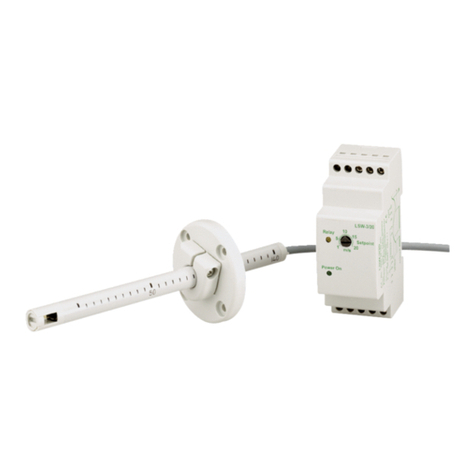
Maico
Maico LW 9 Mounting and operating instructions
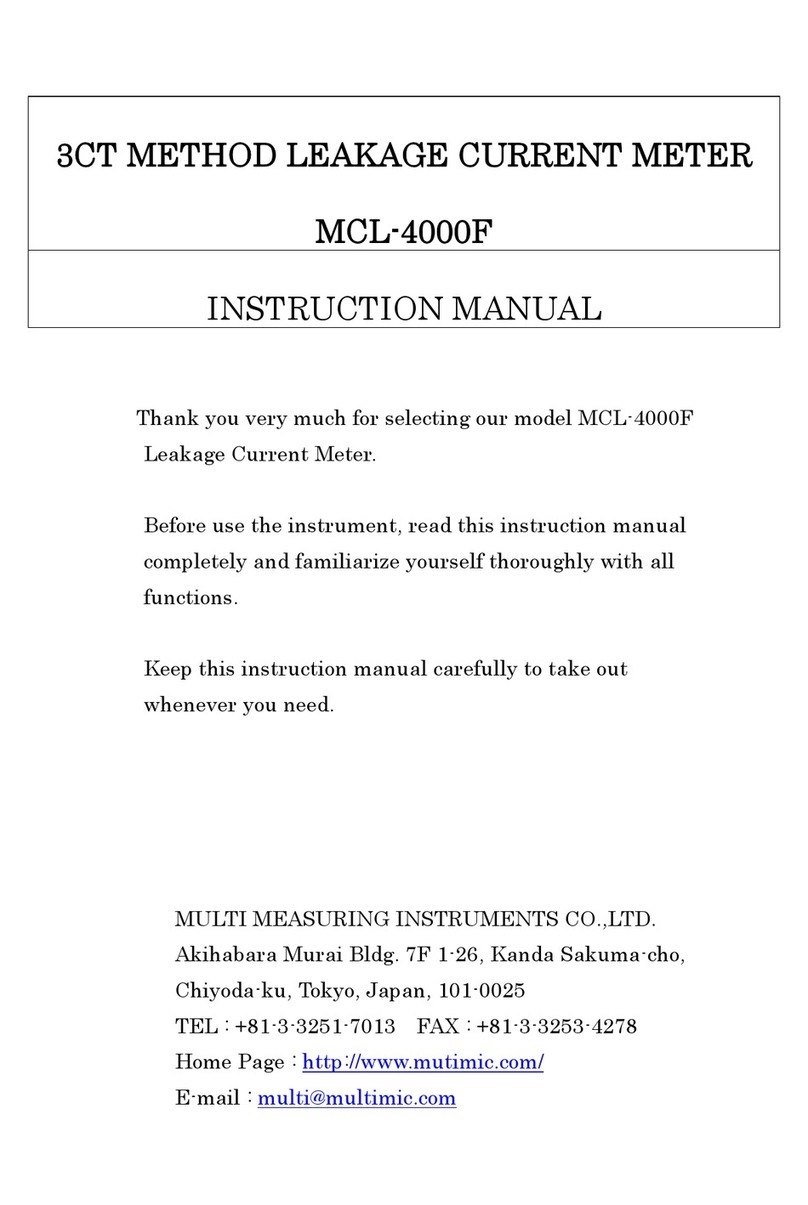
MULTI MEASURING INSTRUMENTS CO.,LTD.
MULTI MEASURING INSTRUMENTS CO.,LTD. MCL-4000F instruction manual
